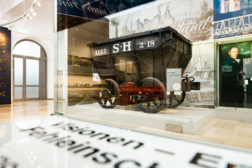Coal wagon
The oldest railway vehicle in the DB Museum
1829
The coal wagon is the oldest rail vehicle in the DB Museum. Built in 1829 for the South Hetton Colliery near Newcastle upon Tyne, England, it symbolises the birth of the railway in Great Britain. The country pioneered the introduction of steam engines much earlier than Germany, mainly for use in textile mills. To help supply the large quantities of coal that steam engines required, British engineers in the 18th century were already looking for ways to facilitate transport of this raw material. An early solution was to construct railway tracks from wooden beams. From 1750 onwards, these were replaced by iron rails, which reduced friction and meant that less power was needed to haul the coal wagons.
The coal wagon exhibited in the DB Museum could transport up to 2.5 tonnes of cargo. Colliery railways of this kind were the first step in the creation of the railway. This was followed by the development of steam locomotives.



